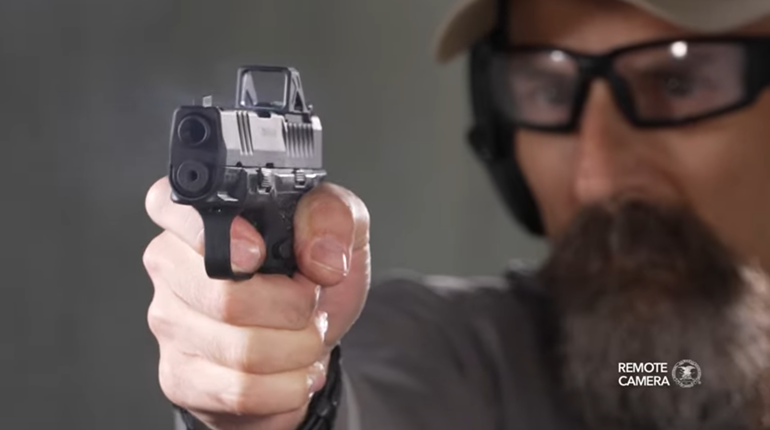
Sometimes correcting injustice takes a little longer than it should. After 111 years, New York’s Sullivan Law was finally struck down by the U.S. Supreme Court on June 23 in the NRA-backed case NYSRPA v. Bruen. The landmark decision was a vital victory in the ongoing battle to secure Second Amendment rights and the result of gun owners’ decades of perseverance.
Enacted in 1911 at the direction of Tammany Hall political boss “Big” Tim Sullivan, the Sullivan Law resulted in a discretionary carry-licensing regime that was used to deny many ordinary, law-abiding citizens their right to bear arms outside the home for self-defense. As with much of early 20th century gun control, the Sullivan Law was used to target disfavored minority groups—chiefly Southern and Eastern European immigrants. In recent decades, the law gave rise to bribery and favoritism. Under the scheme, the rich, famous and well-connected could obtain licenses, but everyday, hard-working New Yorkers were denied their right to carry.
As evidenced by the pages of the American Rifleman precursor Arms and the Man magazine, many gun-rights supporters objected to New York’s pistol-licensing regime from the start.
An article titled “An Obnoxious Arms Law” in the June 8, 1911, edition explained how the Sullivan Law violated constitutional rights, noting, “Ostensibly directed towards the use of concealed weapons by unworthy persons, it actually will accomplish an infringement of the guarantees of liberty contained in the Constitution of the United States.” Pointing out the practical problems with the law, the piece went on to state, “The law may be expected to operate in a prohibitive manner against good citizens, who, if they had weapons, would do no harm with them, and to be inoperative against bad men whose disregard for the laws relative to killing may be expected to extend to other laws.”
NRA members didn’t warm up to the law once they saw it in practice. In 1931 and 1932, a serious effort was made to amend the law to make it easier for law-abiding New Yorkers to exercise their rights.
In May 1932, American Rifleman published an item titled, “Governor Roosevelt Upholds Sullivan Law.” The piece explained how then-New York Gov. Franklin D. Roosevelt rejected legislation passed by the New York State Assembly to repeal and replace the Sullivan Law; it also challenged Roosevelt’s statement that accompanied the veto. The article noted, “[NRA] is grinding no political axe when it takes exception to the shallow, fallacious and uninformed views of the present Governor of New York in regard to the needs of the public welfare in matters pertaining to firearms.”
In his veto message, the governor specifically downplayed the use of handguns for self-defense, to which American Rifleman responded, “readers […] may seriously question just how much alive to important public-welfare problems involving the citizens of his own state Governor Roosevelt has been, in failing to investigate how much theory there is in the self-protection afforded by a good gun in the hands of a man who knows how to use it.” NRA also criticized the “czarist-type police supervision, discrimination and political byplay” attendant to exercising one’s rights in New York.
The May 1936, American Rifleman included a letter from a Brooklyn NRA member that ran with the title “How the Sullivan Law Works.” The member explained that despite his status as a law-abiding businessman with impeccable references, he was unable to secure a carry permit. The member lamented, “You would almost think that criminal lords have such powers that they have issued instructions to the New York Police Department to refuse permits for pistols to all legitimate citizens, so that robbing will not be such a hazardous occupation.” Perhaps foretelling of current New York County District Attorney Alvin Bragg, the member went on to state, “They’ll soon be creating a Society for Prevention of Cruelty to Thieves and Robbers, here in New York.”
A quarter-century later, American Rifleman revisited the history of the Sullivan Law in an April 1962 article titled, “The Sullivan Law: The origin and complexity of New York State’s concealable weapons law.” Identifying the constitutional defect in the law, the piece explained, “The license-issuing authority […] has almost unlimited discretionary power in passing upon a licensing application. Thus, he may, and frequently does, deny an applicant fully qualified in every respect on the arbitrary ground that he does not choose to issue a license.”
Another portion of that item pointed out, “Once a bad law is on the books, it’s terribly difficult to get it off.” With the Sullivan Law, that proved to be an understatement. However, thanks to the resolute efforts of NRA members over the course of the last century, the end of discretionary carry licensing is at hand.
Sadly, some anti-gun politicians have reacted to the Bruen decision by defying the Court and enacting new unconstitutional gun-control measures. These intransigent officeholders could learn something from history. NRA members will continue to work to undo their unjust policies, no matter how long it takes.


































